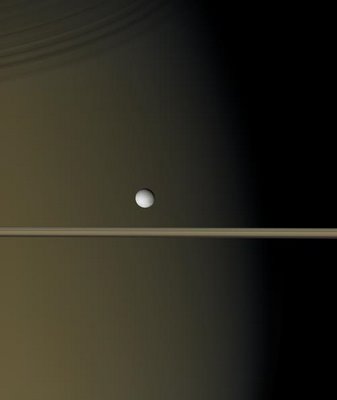This is Enceladus, a tiny, icy pearl of a moon orbiting one of the gas giants beyond Mars. Behind it is the looming bulk of Saturn, clothed in the browns we would see could we be there. Beneath it are some of the famous thin rings, an indication of the dwarf moon's small insignificance. The shadow of the rings on the planet's surface can be seen at top left. Breathtaking, spectacular, unbelievable; the picture clutches me and refuses to let go.
Recently, scientists discovered what they believe to be geysers spewing water on Enceladus. Of course, in the frigid outback of our solar system, the water instantly freezes and creates ice calderas. However, if there is an underground supply of liquid water, it greatly increases the chance of life existing somewhere else in this little backwater of the galaxy. That by itself is fascinating, the stuff that daydreams and wishful what-ifs are made of. I have spent most of my life in love with the idea of otherworldly flora and fauna, pondering the endless beauties and possibilities of that most important of questions: What else is out there?
But that's not what drew me to this photograph.
Enceladus is one of many related gems; its siblings have similarly exotic names: Titan, Tethys, Phoebe, Mimas, Dione. They were set in and around the glorious rings of their master, Saturn. From the beginning they revolved in a slow, silent, sedate dance against the backdrop of an infinite frozen night. Like jewels, they glittered in in the Saturnian sky, brightened by a Sun far away. For millennia upon millennia, it was unchanged.
And Enceladus danced.
Elsewhere, a molten rock cooled, bathed in vapors that condensed into wide seas, weaving a blue mantle across the planet's face. It was a volatile, changing world, thrusting up mountains in its raging growth, then tearing them down in wrathful cataclysms. It coughed and shuddered under the battering of debris from the immediate environs, incorporating the flotsam into its primordial skin, churning the Sun's energy to its own uses.
And Enceladus danced.
The blue world gave birth to living things, first little more than microscopic bubbles, eventually moving, eating, growing, swimming, breathing, walking, building. Over the eons, a vast and remarkable procession of creatures called this place home, each pushing and fighting and reproducing in an unstoppable attempt to fill and claim the young planet.
And Enceladus danced.
Eventually, the first thinking beings emerged to stare up at the sky and ask the first questions, among them What else is out there? These sapient primates learned, adapted, and progressed in ever more complex societies at an alarming rate. Leaders waged wars, prophets preached and foretold, great works were begun and finished or destroyed, science was invented, children were born and died, civilizations rose, flourished, and fell.
And Enceladus danced.
The thinking beings scratched at the heavens, succeeding in sending mechanical probes to the outer neighborhood in attempts to find answers their questions. They were able to send members of their own family in puny, pathetic vessels into that great blackness that was home to all else. And they sent a visitor, a visitor which greeted the children of Saturn, and which took their portrait.
And Enceladus danced.
As it must come to all things, extinction came quick, quiet, and unexpected. In the blink of the universe's unseeing and uncaring eye, the blue world's thinking beings disappeared. All their works, their arts, their very thoughts were obliterated, hidden among the infinite multitudes of stars, covered over by the dust and forgetfulness of years numbering many, many millions.
And Enceladus danced.


4 comments:
That looks like an egg suspended over a pool cue to me.
I swear NASA and whoever fake those photos... and then eat the props :)
Profound, and very insightful. When I lived in France, I stayed in a hostel that was in an 800 year old building... Nearly four times the age of our country! I wondered what things those walls were witness to?
800 year old building? Consider this: If the Earth's lifetime (from it's birth to the present day) were to be measured in one calendar year, the appearance of man would not happen until 11:59:57 PM on December 31st. In other words, in the last 3 seconds. The vastness of time is something we can barely comprehend...
Gorgeous! Wow.
Post a Comment